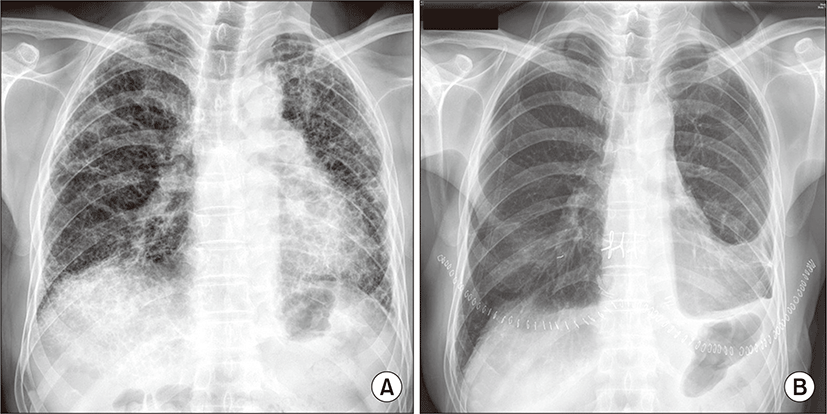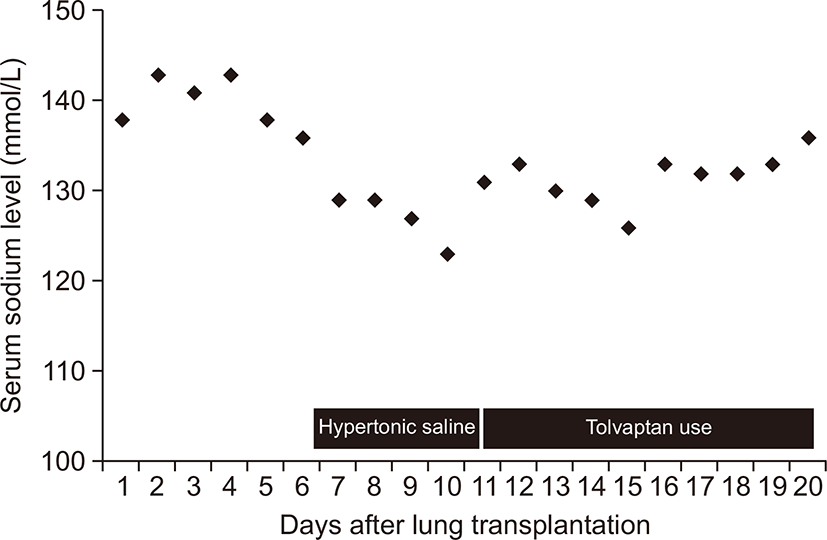Introduction
Hyponatremia is considered to be a frequent complication of many clinical conditions [1]. Euvolemic dilutional hyponatremia caused by water retention in normal sodium stores has been termed as a syndrome of inappropriate antidiuretic hormone (SIADH) [2]. SIADH has been developed in patients with a variety of disorders, including central nervous system disorders, malignancy with autonomous ADH release, drugs and other miscellaneous causes. Pulmonary disease such as pneumonia or lung cancer is frequently combined with SIADH, however, there was no report of SIADH in a patient after lung transplantation (LT). Herein, we describe a case of SIADH after LT, whose hyponatremia was successfully treated with tolvaptan.
Case
A 54-year-old man treated with idiopathic pulmonary fibrosis for several years was admitted to Yonsei University Severance Hospital for LT. He had ten-year history of hypertension and diabetes mellitus and had a medical history of pulmonary tuberculosis cured before 10 years. His medication included aspirin 75 mg once daily, eprosartan 300 mg daily, and pirfenidone 200 mg three times a day. He was a 20 pack-year ex-smoker with moderate alcohol consumption. On physical examination, there was no significant finding except bilateral coarse breathing sound. His blood laboratory results on admission were: serum sodium 139 mmol/L, potassium 4.0 mmol/L, chloride 100 mmol/L, total CO2 25 mmol/L, blood urea nitrogen 25 mg/dL and creatinine 0.62 mg/dL. There was no significant abnormality in urinalysis.
A bilateral double LT under sedation with remifentanyl was performed without any incidents. Seven days after LT, the patient developed nausea and became drowsy without focal neurologic signs. His blood pressure was 136/100 mmHg and pulse rate was 76 beats per minutes. Physical examination revealed no evidence of volume depletion or volume expansion. At the blood test, serum sodium was 129 mmol/L with a serum osmolality of 278 mOsm/kg and a urine osmolality of 493 mOsm/kg. His thyroid function was normal. Adrenocorticotropic hormone (ACTH) level was below 1.0 pg/mL (normal range, 7.3 to 63.3 pg/mL) and a rapid ACTH test showed adrenal failures with cortisol 0.6 μg/dL (normal range, 6.7 to 22.6 μg/dL) at baseline, 3.6 μg/dL at 30 minutes and 2.9 μg/dL at 60 minutes. Since corticosteroid supplementation for immunosuppresion after LT was considered as the cause of hypothalamic-pituitary-adrenal axis suppression and had maintained continuously, it was not likely that adrenal insufficiency was a cause of hyponatremia. A chest X-ray and chest computed tomography were normal except for postoperative changes (Fig. 1). The patient was initially treated with hypertonic saline (3%NaCl, 40 mL/hr for 12 hours) with low dose furosemide (Fig. 2). Despite replacement of hypertonic saline, serum sodium concentration was still low. He was treated with 7.5 mg of tolvaptan daily. Thirty six hours after treatment of tolvaptan, his serum sodium concentration was 133 mmol/L. After improvement in hyponatremia, tolvaptan was maintained and his serum sodium concentration 7 days after tolvaptan treatment was 136 mmol/L. During the follow-up after discontinuation of tolvaptan, hyponatremia did not recur and he was discharged without tolvaptan.
Discussion
Our patient had normal serum sodium level before LT and developed hyponatremia after LT. SIADH was confirmed with hypotonic plasma and inappropriately concentrated urine in the absence of hypovolemia. Cardiac, renal, and thyroid functions were all preserved. Symptomatic hyponatremia, which was persistent despite of hypertonic saline replacement, was resolved after tolvaptan treatment.
Laboratory characteristics of SIADH are following: (1) hyponatremia accompanied by plasma hypo-osmolality, (2) higher urine osmolality compared to plasma osmolality, (3) excessive renal excretion of sodium, (4) absence of volume expansion or depletion, and (5) normal thyroid and adrenal function. SIADH is frequently developed after major surgeries such as intracranial [3,4], abdomen [5] and open heart surgery [6]. It has been known that the stress response and pain to surgery induces release of ADH in hypothalamus [7]. SIADH also occurs in various pulmonary diseases such as asthma, atelectasis, acute respiratory failure, and intra-thoracic malignancy. Potential mechanisms are related with hypoxemia, and hypercapnic acidosis [8]. It has been also explained that hemodynamic changes in the pulmonary blood flow due to either inflammation in lung or an abnormal breathing pattern stimulate the volume receptor and baroreceptor in the left atrium, which regulates ADH release [9]. Nausea and poor oral intake is frequently associated with volume depletion and decrease serum sodium levels via potentiation of ADH release. But in our case, the patient did not have a symptom of nausea until serum sodium level was lower than 130 mEq/L. Since a present patient did not feel pain and already passed 7 days after LT, SIADH was probably arisen from inflammatory process and subsequent hemodynamic abnormality after LT.
Tolvaptan, a novel, orally active, selective, non-peptide V2 receptor antagonist blocks arginine vasopressin from binding to V2 receptors of the distal nephron. This drug induces the excretion of electrolyte-free water without changing electrolyte excretion [10]. Two multicenter, randomized, double-blind, placebo-controlled trials, which evaluated the efficacy of tolvaptan in patients with euvolemic or hypervolemic hyponatremia [11], demonstrated a significant increase in the mean serum sodium concentration after 4 days of therapy compared to the placebo. In the present case, tolvaptan successfully corrected hyponatremia resistant to hypertonic saline replacement.
Considering the association between SIADH and pulmonary disease, SIADH can occur after LT. However, there has been no report of a case of SIADH in a patient with LT. Herein, we report a patient with SIADH after LT, whose serum sodium levels were normalized after tolvaptan treatment.

